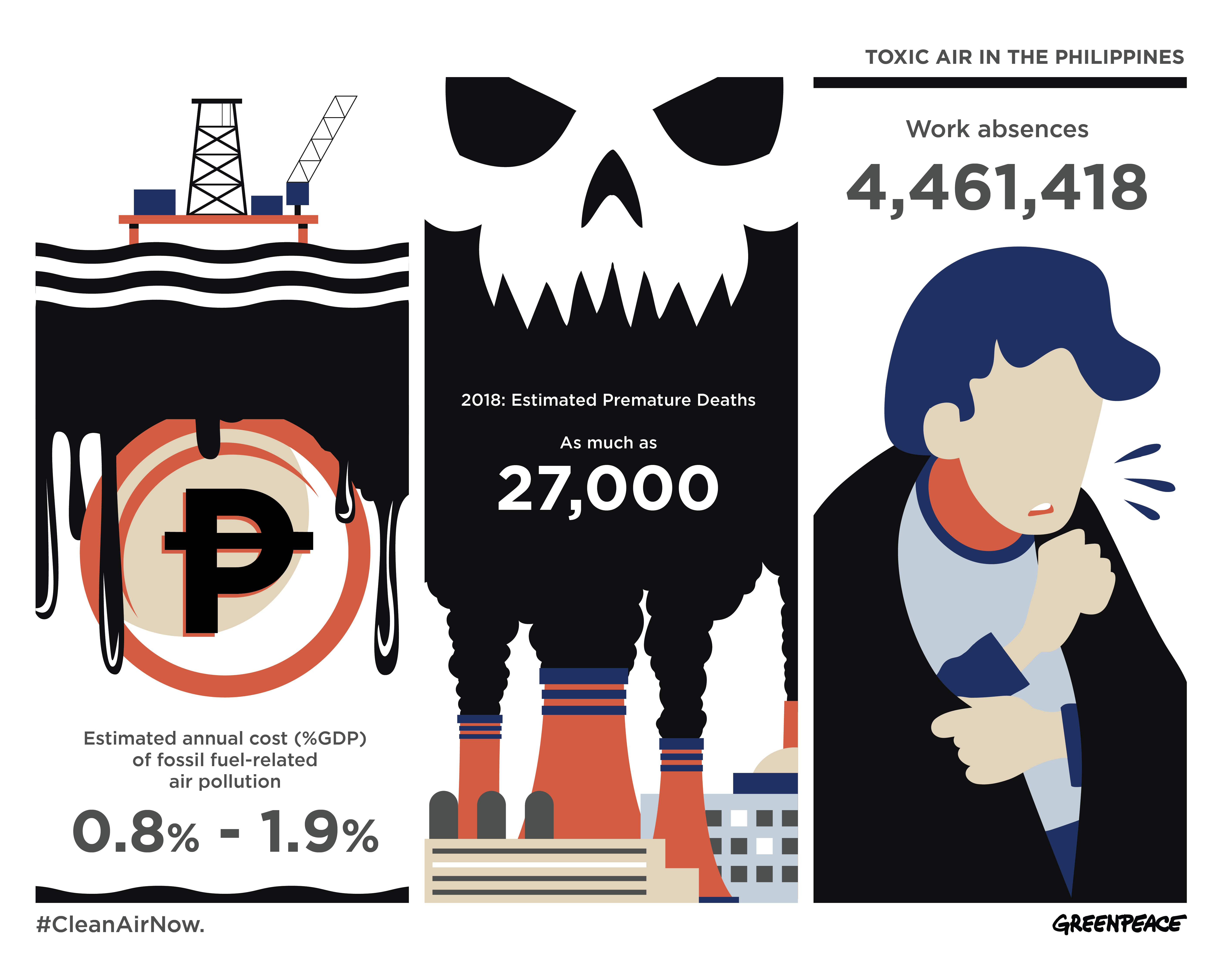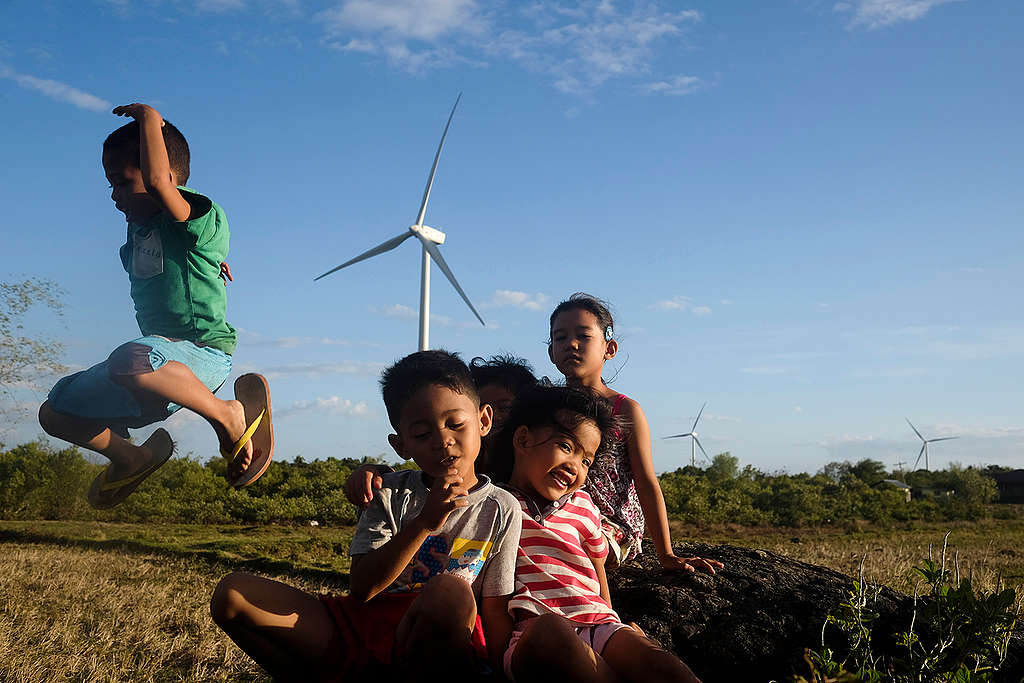Quezon City—Air pollution is a silent killer in the Philippines, and the government must take urgent steps to address the problem before it gets worse.
Environmental, science, and health groups today raised the alarm following recent reports on poor air quality in the country. A global report launched this week showed that air quality in the Philippines contains PM2.5 pollution[1] levels that significantly exceed the safety limits prescribed by the World Health Organization (WHO).
The groups — Greenpeace Philippines, Clean Air Asia, Center for Energy, Ecology and Development (CEED), Health Care without Harm, the Philippine Movement for Climate Justice (PMCJ), and the World Wildlife Fund for Nature (WWF) Philippines — additionally called on the Philippine government to revamp and improve current air pollution monitoring systems in order to provide more reliable information on whether the air in our communities is still safe for daily living.
Khevin Yu, Campaigner, Greenpeace Philippines:
“The Philippine government should see the data as an impetus to overhaul air quality monitoring systems in the country, as well as to transition away from highly polluting facilities such as coal plants. Our safety standards for air pollution haven’t changed since 1999. But what’s worse is that there are still no efficient air quality monitoring systems in place. This situation has allowed industries and facilities to pollute the air we breathe with impunity. The good news is that the solutions to air pollution are also solutions to the climate crisis, and addressing air quality now will not just improve the liveability of our cities and municipalities, but also move the country away from dependence on fossil fuels.”
The recent 2019 Air Visual report places the Philippines in the 58th spot out of 98 countries with locations from where air quality data was collected. But the groups emphasize that while available Air Visual data did not place the Philippines as among the countries with the worst air quality, the data nevertheless shows that the country still has very polluted air. Year-on-year data also shows that the country’s air quality is getting worse. Average PM2.5 pollution levels in Air Visual sites increased from 14.6 μg/m3 (micrograms per cubic meter) in 2018 to 17.6 μg/m3 in 2019. The safety limit set by the WHO is 10 μg/m3.

The groups also noted that the report only looks at PM2.5 pollution, and does not include other pollutants such as sulfur oxide, nitrous oxide, ozone and other contaminants that carry deleterious health risks. A report released by Greenpeace Philippines earlier this month showed that these and other toxic emissions can cost Filipinos as much as 1.9% GDP loss and 27,000 premature deaths. [2]
The groups are calling for better air pollution standards in the Philippines, including improved monitoring, transparency and analysis. In the case of the 2019 Air Visual report, the quantity and placement of air monitors from which data were collected provide only a small snapshot of the threat of PM 2.5 air pollution. To be effective, the groups say that the government should monitor places close to main sources of air pollution, such as coal-fired power plants and high traffic areas of motorized vehicles.
Further, the groups have called for the following measures to address the impacts of air pollution:
- President Duterte to declare air pollution as a national issue and to order all line agencies involved in air quality monitoring and regulation to prioritize this issue
- Enhance transparency and expedite the review and update of the air pollution standards under Republic Act 8749 or the Clean Air Act of 1999
- Issue a moratorium on all Permits to Operate Air Pollutant Installations especially for proposed coal power plants until the Ambient Air Quality Guideline Values and Standards and Emission Standards are updated
- Make air pollution monitoring devices mandatory in all cities, government offices, particularly in heavy polluting industries/facilities such as coal power plants and in areas with high concentration of motorized vehicles
- Allocate more funds and manpower to the Department of Environment and Natural Resources to increase their capacity in air quality monitoring, including enabling the department to install its own emissions monitoring devices in existing coal power plants and, in the meantime, adopt a stringent process for validating self-monitoring reports of emissions rates
- Fully prepare and implement a National Plan on the Reduction of GHG, as mandated by Section 31 of the Philippine Clean Air Act
- Address the root cause of air pollution in the country by implementing a transition plan away from the use of coal energy and fossil fuels in the transport sector. Address the root cause of air pollution in the country by implementing a transition plan away from the use of coal energy and fossil fuels in the transport sectorPresident Duterte to declare air pollution as a national issue and to order all line agencies involved in air quality monitoring and regulation to prioritize this issue
- Enhance transparency and expedite the review and update of the air pollution standards under Republic Act 8749 or the Clean Air Act of 1999
- Issue a moratorium on all Permits to Operate Air Pollutant Installations especially for proposed coal power plants until the Ambient Air Quality Guideline Values and Standards and Emission Standards are updated
- Make air pollution monitoring devices mandatory in all cities, government offices, particularly in heavy polluting industries/facilities such as coal power plants and in areas with high concentration of motorized vehicles
- Allocate more funds and manpower to the Department of Environment and Natural Resources to increase their capacity in air quality monitoring, including enabling the department to install its own emissions monitoring devices in existing coal power plants and, in the meantime, adopt a stringent process for validating self-monitoring reports of emissions rates
- Fully prepare and implement a National Plan on the Reduction of GHG, as mandated by Section 31 of the Philippine Clean Air Act
- Address the root cause of air pollution in the country by implementing a transition plan away from the use of coal energy and fossil fuels in the transport sector
Notes:
[1] PM2.5 is the term for fine particulate matter that is less than 2.5 micrometers in diameter. This pollutant can come from various sources, especially combustion of fuels. Because of its small size, it can impair lung function and is known to cause respiratory illnesses, heart disease, and premature death.
[2]https://www.greenpeace.org/philippines/publication/4066/toxic-air-the-price-of-fossil-fuels/

Renewable energy is the key to our country’s energy independence. But coal companies and politicians are holding us back.

Discussion
AirVisual air quality data in Manila is highly unreliable. Most of people register stations and then move them in-house instead of keepign them outsdie. As a consequence reports from Manila paint much more rosy picture then it really is. Take for example today, in Makati, Ayala Triangle, where I live, the air pollution was reaching 120 (red), yet most stations around were showing 50-60 (green to yellow)